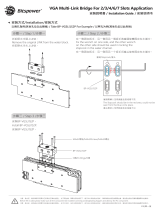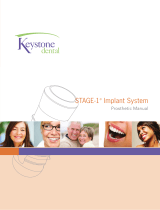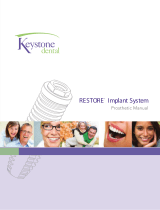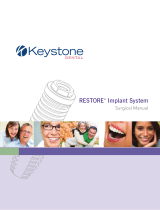Page is loading ...

403353003_001 ID 2023-06-20
Manufactured For:
Merit Medical Systems, Inc.
1600 West Merit Parkway, South Jordan, Utah 84095 U.S.A.
1-801-253-1600 U.S.A Customer Service 1-800-356-3748
Authorized Representative:
Merit Medical Ireland Ltd, Parkmore Business Park West, Galway, Ireland
EC Customer Service +31 43 35882X
www.merit.com
English
BONE CEMENT AND SATURATE MIXING SYSTEM
StabiliT®
IMPORTANT INFORMATION – PLEASE READ BEFORE USE
CAUTION: Federal law (USA) restricts this device to sale by or on the order of a physician.
INDICATIONS
The StabiliT® Bone Cement and Saturate Mixing System is intended for:
• The StabiliT Bone Cement is indicated for the treatment of pathological fractures of the vertebrae using a vertebroplasty, or
kyphoplasty procedure. Painful vertebral compression fractures may result from osteoporosis, benign lesions (hemangioma),
and malignant lesions (metastatic cancers, myeloma).
• The Saturate Mixing System is intended for mixing of StabiliT Bone Cement.
DESCRIPTION
The StabiliT Bone Cement is a polymethylmethacrylate (PMMA) radiopaque bone cement. The StabiliT Bone Cement and
Saturate Mixing System is packaged sterile. Components include a vial of a colorless, ammable liquid monomer that has
sweet slightly acrid odor, a Cement Syringe Assembly packed with ne powder, a locking syringe which provides a vacuum
source and a Stopcock assembly. To the liquid component, Hydroquinone is added to prevent premature polymerization
and N-Dimethyl-p-toluidine is added to promote cold curing of the finished therapeutic bone cement. To the powder
component, barium sulphate is added to assist in visualization of bone cement under standard imaging. When the powder
and liquid components are mixed, an exothermic reaction occurs resulting in a liquid that progressively hardens as a cement-
like complex.
The composition of StabiliT Bone Cement is High Viscosity Spinal Cement
Powder 10.5g of Sterile Powder
Polymethyl Methacrylate 69.50 % w/w
Barium Sulphate 30.00 % w/w
Benzoyl Peroxide 0.50 % w/w
Liquid 4.2 g of Sterile Liquid
Methyl Methacrylate 99.50 % w/w
N,N-Dimethyl-p-toluidine 0.50 % w/w
Hydroquinone 75 ppm
HOW SUPPLIED
The StabiliT Bone Cement and Saturate Mixing System is provided sterile. The powder (10.5g) is sterilized by ethylene oxide
gas. The liquid (4.2g) is sterilized by ltration method and the outer surface of the vial is sterilized by ethylene oxide gas. The
locking syringe and Stopcock are sterilized by ethylene oxide gas. This device is intended for single use only. Do not resterilize.
Do not use if the package is open or damaged.
CONTRAINDICATIONS
• This product is contraindicated with patients with coagulation disorders, or with severe pulmonary insuciency.
• Product use is contraindicated with patients with extended vertebral collapse superior to 2/3 of the standard thickness, and
destruction of the posterior wall with epidural extension of the pathologic tissue and clinical signs of medullar compression.
• PMMA bone cement is contraindicated in the presence of active or incompletely treated infection, at the site where the cement
is to be applied.
• This product should not be used in patients with sensitivity to any of the components of the PMMA bone cement.
• Evidence of safety for use of this material in children or during pregnancy or lactation has not been established.
WARNINGS
• Cement leakage may cause tissue damage, nerve or circulatory problems, and other serious adverse events.
• Sterility is assured only if the unit container is not damaged or opened.
• Do not use after the Use By Date.
• Do not use damaged product. Before use, inspect the StabiliT Bone Cement and Saturate Mixing System components and
packaging to verify that no damage has occurred.
• Store the package in a dry ventilated place at a temperature below 25ºC and away from direct light.
• Do not re-sterilize and/or reuse any of the components. The StabiliT Bone Cement and Saturate Mixing System is for single
use only. Reconditioning, refurbishing, repair, modication, or resterilization of the device to enable further use is expressly
prohibited as it may result in loss of function and/or infection,
• For an ecacious use of StabiliT Bone Cement and Saturate Mixing System, the operator should have specic training and
experience to be thoroughly familiar with the properties, handling characteristics, and application of the cement.
• Adverse patient reactions aecting the cardiovascular system have been associated with bone cements. Hypotensive reactions
have occurred between 10 and 165 seconds following application of bone cement; they have lasted from 30 seconds to 5
minutes. Some have progressed to cardiac arrest. Patients should be monitored carefully for any change in blood pressure during
and immediately following the application of bone cement
• The liquid is highly volatile and ammable. The operating room should be adequately ventilated to eliminate as much monomer
vapor as possible. Additionally, care should be taken in the use of electrocautery in the presence of freshly implanted bone
cement.
• Caution should be exercised during mixing of the two components to prevent excessive exposure to the concentrated vapors of
the monomer, which may produce irritation to the respiratory tract, eyes, and possibly the liver. Because soft contact lenses are
quite permeable, personnel wearing contact lenses should not be near or involved in mixing the bone cement.
• Polymerization of this bone cement is an exothermic reaction, which occurs while the cement is hardening in situ. The released
heat may damage bone or other tissues surrounding the implant.
• Avoid over pressurization of the bone cement because this may lead to extrusion of the bone cement beyond the site of its
intended application and damage to the surrounding tissues.
PRECAUTIONS
• This device should only be used by licensed physicians with training in the clinical procedure in which it is being used.
• For proper use of the StabiliT Bone Cement and Saturate Mixing System, the surgeon should have specic training, experience,
and thorough familiarity with the use and application of this product.
• Use appropriate imaging techniques to conrm correct needle placement, absence of damage to surrounding structures and
appropriate location of injected material.
• Percutaneous vertebroplasty, vertebral augmentation or kyphoplasty procedures should only be performed in medical settings
in which emergency decompressive surgery is available. It is essential to maintain strict sterile technique during the procedure
and during all phases of handling this product.
• Follow the handling and mixing instructions carefully to ensure that the cement has reached the appropriate consistency. This
will prevent incompletely mixed material from either being injected or clogging the delivery device. Failure to follow the mixing
instructions or premature injection of material may negatively aect the outcome of the procedure.
• Do not continue injection beyond the working time of the bone cement. Attempting to inject the material beyond the working
time may result in failure of the delivery system.
• Wear safety glasses or a face shield when delivering the material. Follow handling and mixing instructions to avoid contact
dermatitis. Wearing a second pair of gloves and strict adherence to the mixing instructions may diminish the possibility of
hypersensitivity reactions. The liquid component is a powerful lipid solvent. Do not allow the liquid component to contact latex
gloves.
• Dispose the powder component in an authorized waste facility. The liquid component should be evaporated under a well-
ventilated hood or absorbed by an inert material and transferred in a suitable container for disposal.
ADVERSE EVENTS
Serious adverse events, some with fatal outcome, associated with the use of acrylic bone cements for vertebroplasty or
kyphoplasty include myocardial infarction, cardiac arrest, cerebrovascular accident, pulmonary embolism, and cardiac
embolism. Although the majority of these adverse events present early within the post-operative period, there have been
some reports of diagnoses beyond a year or more after the procedure.
The most frequent adverse reactions reported with acrylic bone cement intended for vertebroplasty, vertical
augmentation or kyphoplasty are:
• Transitory fall in blood pressure • Thrombophlebitis
• Hemorrhage and hematoma • Supercial or deep wound infection
• Bursitis • Short-term cardiac irregularities
• Heterotopic bone formation
Other reported adverse events for acrylic bone cements intended for vertebroplasty, vertical augmentation or
kyphoplasty include
• Leakage of the bone cement beyond the site of its intended
application with introduction into the vascular system
resulting in embolism of the lung and/or heart or other clinical
sequelae.
• Pyrexia
• Dysuria
• Adhesions and stricture of the ileum due to heat released
during polymerization
• Transitory worsening of pain due to heat released during
polymerization
• Anaphylaxis
• Hematuria
• Bladder stula
• Nerve entrapment and dysphasia due to extrusion of the bone
cement beyond its intended application
Potential adverse events associated with vertebroplasty, vertebral augmentation or kyphoplasty include:
• Pneumonia
• Collapse of a vertebra adjacent to the one injected, due to
osteoporotic disease
• Extravasation of cement into soft tissue
• Rib fracture in patients with diffuse osteopenia, especially
during thoracic vertebroplasty, vertical augmentation or
kyphoplasty procedures, due to the significant downward
force exerted during cannula insertion
• Intercostal neuralgia
• Pneumothorax
• Fracture of a pedicle
• Diffusion of the resin outside the vertebral body: in the
peripheral veins (pulmonary embolism), in the epidural plexus
(myelopathy, radiculopathy), in the intervertebral disc.
• Compression of the spinal cord with paralysis or loss of feeling
INSTRUCTIONS FOR USE
DIRECTIONS FOR USE
For proper mixing and use, follow this IFU and StabiliT System used IFU.
1. It is important to read the IFU for StabiliT VP and the precautions prior to device operation.
2. Remove the following components from the StabiliT Bone Cement and Saturate Mixing System:
a. Cement Syringe with powder and attached Funnel and Syringe Filter
b. Stopcock with Cap
3. Be sure all air is pushed out of the Locking Syringe prior to attaching to Stopcock.
4. Securely attach the Stopcock to the Locking Syringe at the middle luer connector of the Stopcock.
5. If not already, rotate the Stopcock o lever towards the Locking Syringe to temporarily close o ow and secure orange cap to
Stopcock.
6. Draw 30cc of vacuum and rotate the Locking Syringe plunger to lock plunger in place. Caution: Do not apply more than or less
than 30cc vacuum. Device malfunction may occur during cement delivery.
7. Ensure the Funnel is secured to the Cement Syringe and the cap is secured to the Funnel.
8. Rotate powder lled Cement Syringe back and forth while rolling to mix powder.
9. Gently tap the tip of syringe lter against table top for 10 seconds
10. Carefully remove cap from top of Cement Syringe.
11. Firmly attach the powder lled Cement Syringe, Funnel and Syringe Filter to the Stopcock and the Locking Syringe with the
plunger locked at 30 cc volume (see Figure 5). NOTE: Inadequate joining of the Syringe Filter to the Stopcock can result in poor
cement mix and device malfunction.
12. Open the liquid glass vial and pour the entire contents into the Funnel and immediately rotate the Stopcock off lever
DOWNWARDS towards the orange cap per Figure 6. Caution: Be careful when breaking glass vial of liquid monomer. Be careful
when pouring liquid into the Funnel to avoid injury. Caution: Ensure the entire contents of the liquid ampule are emptied into
the Cement Syringe/ Funnel without spilling prior to applying vacuum. NOTE: Closely observe the progression of the monomer
liquid as it saturates through the powder. When the liquid reaches the Syringe Filter luer and no excess monomer present in
Funnel, the saturation of the powder with monomer is complete (approximately 20 seconds). Caution: Only apply vacuum
for the prescribed period of time. If longer or shorter duration is used, device malfunction may occur during cement delivery.
Immediately close o Stopcock by rotating lever UPWARD, then separate the Syringe Filter from the Stopcock to relieve vacuum
pressure
13. Note the time when cement mixing was initiated as this is critical for cement performance. ONLY after 4:00 minutes (or 9:00
minutes if room temperature is ≤67°F (≤19°C)) has elapsed, remove the Syringe Filter and Funnel from the Cement Syringe and
wipe excess cement o the top of the Cement Syringe. NOTE: Proceeding without allowing 4:00 minutes (or 9:00 minutes if room
temperature is ≤67°F (≤19°C)) to elapse will result in poor cement mix and device malfunction.
14. Pointing the Cement Syringe luer down, tap the luer opening of the Cement Syringe to assure that little or no excess dried
powder comes out of the Cement Syringe. NOTE: If dry powder is observed coming out of the Cement Syringe, the saturation
was not complete and a new cement mix should be performed.
15. Connect the Master Syringe to the Cement Syringe per StabiliT VP System IFU. Ensure the threads are fully engaged. CAUTION:
Deviating from the mixing instructions in this IFU will result in inadequate cement delivery. CAUTION: Never arbitrarily alter
the powder to liquid ratio. CAUTION: Bone cements are sensitive to temperature. Any increase in temperature of the working
environment, the cement components, or the mixing instrumentation reduces the times indicated in the tables below.
Conversely, lower temperatures increase the times indicated in the tables below.
Table 1: Cement delivered using StabiliT System.
Operation Activity
Approximate Cumulative
Time From Initiation of
Saturation at 18-19 °C
(minutes)
Approximate
Cumulative Time From
Initiation of Saturation
at 20-23 °C (minutes)
Saturation Saturation of the powder 0-9 0-4
System Preparation Attaching Cement Syringe to Master Syringe 9-10 4-5
Working Injection of cement into vertebral body See IFU for StabiliT System
used
See IFU for StabiliT
System used
Setting Bone Cement fully hardened See IFU for StabiliT System
used
See IFU for StabiliT
System used
Table 2: Eect of Ambient Temperature on Cement.
Temperature ºF (ºC) Minimum Setting Time, Cement Only (Minutes)
81 (27) 35
73 (23) 51
66 (19) 82
STORAGE & HANDLING
The StabiliT Bone Cement and Saturate Mixing System should be stored in its original packaging materials. Proper care should
be taken to ensure that the StabiliT Bone Cement and Saturate Mixing System will not be damaged. Store below 25°C and
away from direct sunlight.
SYMBOL GLOSSARY
Figure 1:
Components
of StabiliT Bone
Cement and
Saturate Mixing
System
Figure 2:
Assemble
Stopcock
to Locking
Syringe
Figure 3: Rotate
Stopcock handle
to close o Locking
Syringe
Figure 4: Draw
30cc of vacuum
with o lever
turned to the
Locking Syringe,
and rotate
plunger to lock.
Figu re 5:
Securely
join Syringe
Filter luer and
Stopcock
Figure 6: Pour entire
contents of liquid
vial of StabiliT Bone
Cement into Funnel
BEFORE rotating
Stopcock lever
downwards.
Figure 7:
Saturation of
powder as liquid
progresses
through the
Cement Syringe
is visible.
(Saturate fully)
Figure 8:
Separate
Syringe Filter
from Stopcock
after saturation
is complete (to
syringe lter).
Figure 9: Only
remove Funnel
and Syringe Filter
immediately prior
to use.
Caution Use By Do not resterilize
Consult Instructions
for Use Store below 25°C Do not use if package is
opened or damaged
Authorized
Representative in the
European Community Keep away from sunlight
Single Use
Single Use Device
DO NOT REUSE
Sterilized using Ethylene
Oxide Keep away from
moisture Manufacturer
Sterilized using Asceptic
Processing Techniques Flammable QTY: Quantity
LOT
Lot Number No Latex Catalog Number
Federal (USA) law restricts this device to sale by or on the order of a physician.
/








